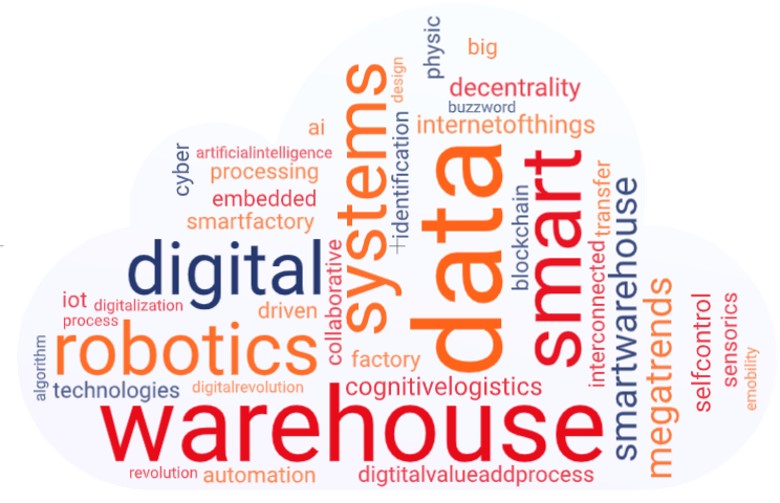There is hardly a topic at the moment that does not involve “data” or “digitization”. “Buzzwords relating to data have never been more present in everyday language; just compare a news broadcast in 2021 with one from before 2020. It’s incredible what people who are not data-savvy are being asked to do.
“Logistics is both an interdisciplinary science and an industry or operational function in organizations concerned with the planning, control, optimization, and execution of flows of goods, information, and people.” Logistics – Wikipedia
… “planning”, … “control”, … “optimization” of … “information” – ? – but it is also about “implementation”. That comforts.
As the definition already reveals, the topic of “data” in all its facets is probably the most central topic of all in logistics. Which logistics expert wouldn’t like to have the “digital twin” of their own business? Of course, senior management would also like that – supply chain at the push of a button. But how realistic is that in practice and how identical is the respective twin? Does the topic of “data” even exist in a clear form?

Clear answer: No. And really in every project with which proLOG comes into contact, the topic complex “data” plays a different mostly very central but always individual role. And no, there is no “patent remedy” with which all projects can be grasped or solved.
Therefore, at the beginning of each project there is an individual analysis of the possibilities and development of the approach and methodology for the project. In most cases, this already requires a deep penetration into the subject matter in order to assess feasibility. In this context, the informative value and process congruence of data of any kind must also be evaluated, i.e. how accurately can physical processes be traced on the basis of data, because only then does the data paint a good and reproducible picture of the processes.
Of course, there are proven procedures, tools, and standards for approaching the topic. In logistics, for example, the key data components of intralogistics are always material data, inventory data and movement data, and in transportation the shipment data, tariffs, etc., which are often also available in standardized form.
However, mostly only past data is available, sometimes very detailed and structured, in the rarest cases there is already a similarly granular view of the present or even forecasts of future data. The further into the future one wants to go, the denser the fog becomes and already in the range of 1-2 years we often reach limits where supply chain partners such as carriers cannot guarantee rates because their own network is in flux – understandable and only human.
Very often, projections into the future require the involvement of a wide variety of stakeholders in the company, and usually structural data must be considered in the form of various conceivable sub-scenarios in so-called “clusters” such as e-commerce, retail, export, express deliveries or replenishment of local sites. In the rarest of cases, there is already agreement here and a clear as well as sufficiently granular view for location and network planning.
In many cases, it is also necessary to take a holistic look at considerations regarding the transport network with intralogistic considerations at site level. After all, what does “next-day delivery” mean and what influences are there? Does everything depend on the last mile or can something be done earlier in the chain? For example, by sending the critical shipments concerned earlier (keywords: early cutoff, early disembark, linehaul, direct feed, etc.)?
An important aspect of the overall issue is the long-term and irreversible development that, among many other changes, the approach to projects has fundamentally changed in recent decades. Planning with fixed data frameworks is hardly to be found anymore, and if it were, this would be very alarming. After all, aren’t we just in the process of putting agility in the foreground in the course of digitalization?
For logistics, this means that growth paths and data frameworks with terms of 10 years are definitely a thing of the past and must be. A proven solution to this seemingly resulting dilemma is the definition of scenarios from differently combined business clusters, which mixed with megatrends, industry and competitive know-how, business strategies and market forecasts can serve as “guard rails” of a future development and as valid data basis and structural data of a logistics project.
Exact planning and prediction of the future, as was so often attempted in vain in the past, are giving way to adaptive and resillient conceptual approaches which, while remaining within the guard rails, are not given a concrete form until as late as possible. New technologies are thus also given space; “adaptivity” is understood as the ability to adapt both to new technologies and to future requirements. Before adaptivity sets in, resilience of a concept has already taken effect in that changed requirements have already been coped with to a certain extent. Resilience can be integrated into planning in a targeted manner by designing processes that are as independent as possible of critical and variable input variables.
Adaptivity is a much more appropriate term than the often used, yet not very specific and nevertheless “hyped” word “flexibility”.
